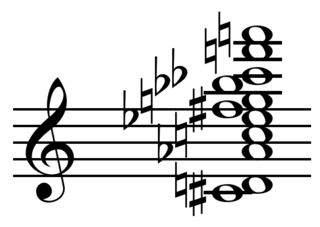
Aleatoricmusic is music in which some element of the composition is left to chance, and/or some primary element of a composed work's realization is left to the determination of its performer(s). The term is most often associated with procedures in which the chance element involves a relatively limited number of possibilities.

Giannis Klearchou Xenakis was a Romanian-born Greek-French avant-garde composer, music theorist, architect, performance director and engineer.
Granular synthesis is a sound synthesis method that operates on the microsound time scale.

François-Joseph Fétis was a Belgian musicologist, critic, teacher and composer. He was among the most influential music intellectuals in continental Europe. His enormous compilation of biographical data in the Biographie universelle des musiciens remains an important source of information today.
Nomos Alpha is a piece for solo cello composed by Iannis Xenakis in 1965, commissioned by Radio Bremen for cellist Siegfried Palm, and dedicated to mathematicians Aristoxenus of Tarentum, Évariste Galois, and Felix Klein. This piece is an example of a style of music called, by Xenakis, symbolic music – a style of music which makes use of set theory, abstract algebra, and mathematical logic in order to create and analyze musical compositions. Along with symbolic music, Xenakis is known for his development of stochastic music.

In musical composition, a sound mass or sound collective is the result of compositional techniques, in which, "the importance of individual pitches", is minimized, "in preference for texture, timbre, and dynamics as primary shapers of gesture and impact", obscuring, "the boundary between sound and noise".

Metastaseis is an orchestral work for 61 musicians by Iannis Xenakis. His first major work, it was written in 1953–54 after his studies with Olivier Messiaen and is about 8 minutes in length. The work was premiered at the 1955 Donaueschingen Festival with Hans Rosbaud conducting. This work was originally a part of a Xenakis trilogy titled Anastenaria but was detached by Xenakis for separate performance.

Stéphane de Gérando is a French composer, conductor, multimedia artist, and researcher.

Game piece is a concept of experimental music having its roots with composers Iannis Xenakis, Christian Wolff and John Zorn. Game pieces may be considered controlled improvisation. An essential characteristic is that there is no pre-arranged sequence of events. They unfold freely according to certain rules, like in a sports game. Therefore, game pieces have elements of improvisation. A number of methods can be used to determine the direction and evolution of the music, including hand gestures. Zorn's game piece "Cobra", which has been recorded several times for various labels, uses a combination of cards and gestures and can be performed by an ensemble of any size and composition. Zorn's game pieces, written in the late 1970s and mid-1980s, include Cobra, Hockey, Lacrosse, and Xu Feng.
Herma is a piece for solo piano composed by Iannis Xenakis in 1961. About ten minutes long, it is based on a formulation of the algebraic equations of Boolean algebra, and is also an example of what Xenakis called symbolic music.
Pithoprakta (1955–56) is a piece by Iannis Xenakis for string orchestra, two trombones, xylophone, and wood block, premièred by conductor Hermann Scherchen in Munich in March 1957. A typical performance of the piece lasts about 10 minutes.
Jimmie LeBlanc is a Canadian composer specializing in instrumental and mixed music. His music has been performed throughout his native country and internationally, including by the Ensemble Contrechamps, Hwaum Chamber Ensemble, Kore Ensemble, Les Enfants Terribles, Nouvel Ensemble Moderne, Pentaèdre, Quatuor Bozzini, and the Trio Fibonacci, and many soloists.

Polytope de Montréal was a media installation in the French Pavilion, which now houses the Montreal Casino. The installation included a sculpture, light show, and musical composition designed and composed by Iannis Xenakis for Expo 67, the 1967 International and Universal Exposition. The piece was the first of many such installations by Xenakis.
Maurice Fleuret was a French composer, music journalist, radio producer, arts administrator, and festival organizer.

Henry Prunières was a French musicologist, and international proponent of contemporary art in various forms, including music, dance and painting. He occupies an important place in the art world between the wars, particularly with regard to music. His major contribution La Revue musicale, a monthly musical periodical which he founded in 1920 and left in 1939, is still a reference in the Western musical world.

Antikhthon is a ballet for orchestra composed by Iannis Xenakis in 1971.

Keqrops is a composition for piano and orchestra by Greek/French composer Iannis Xenakis. Due to the prominent role of the piano soloist, it has often been classified as a piano concerto. It was completed in 1986.
Makis Solomos is a Franco-Greek musicologist who specializes in contemporary music, particularly the work of Iannis Xenakis and Theodor W. Adorno. His work focuses on the issue of sound ecology and decay. He has published articles and books and participates in meetings and symposia. In 2005, he participated in the creation of the magazine "Filigranes," which aimed to broaden the field of musicology.

Claude Samuel was a French music critic and radio personality.
Eonta is a composition for piano, two trumpets, and three tenor trombones by Iannis Xenakis. It was written in 1963–64, and was premiered on December 16, 1964, by the Ensemble du Domaine Musical, with Yuji Takahashi on piano and Pierre Boulez conducting. Its duration is approximately 18 minutes.









